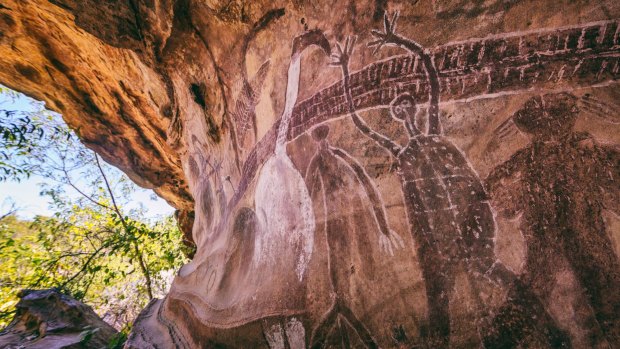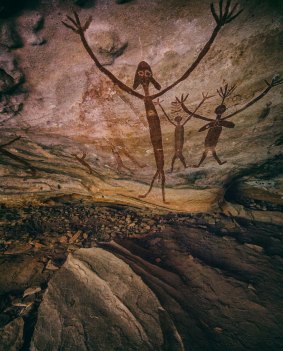This was published 4 years ago
Magnificent Gallery: Where to see some of Australia's best preserved Aboriginal rock paintings
By Kerry van der Jagt

Quinkan rock art sites in Cape York.Credit: Matt Glastonbury
"The land will speak to you," said Johnny Murison, when we entered the country of his ancestors. "You just need to listen."
It's my first night on Kuku-Yalanji country on Cape York Peninsula and already I've smashed my iPhone, lost my reading glasses and all three of my pens have mysteriously stopped working. As I've been warned, there's nothing subtle about the spirits of the old people when they want your attention.

The paintings look like they're about to spring to life.Credit: Matt Glastonbury
I pack away my now-useless notepad and turn off my headlamp as a full moon turns a stand of trees into spirited dancers silhouetted against the walls of my tent. Alone in the dark, the breeze becomes the earth's breath, exhaling after a long day; the thud-thud of a wallaby is its beating heart; and the murmur of leaves is a lullaby. I sleep easily, cradled by an ancient landscape as old as time itself.
I'm on Quinkan Country, named after the Quinkan spirits that are depicted in many of the rock art caves scattered amid these sandstone escarpments. While the world-famous Quinkan rock art sites around Laura are the open to the public – complete with sealed roads, boardwalks and interpretive signs – Johnny has started Jarramali Rock Art Tours to offer a small number of guests an overnight, fully-immersive adventure.
"In 2016 my cousin and I stumbled upon a 40-metre-long gallery," says Johnny, as we leave Cairns for the five-hour, four-wheel-drive journey. "Untouched by the modern world these paintings are some of the best preserved in the region."
Leaving the city behind we cross from Irigani to Djabugai to Mulurridji country, with Johnny taking the opportunity to teach me about the imperceptible skeins that separate one Indigenous nation from another, each with its own distinctive culture, beliefs and language. Under his guidance, Lighthouse Mountain becomes Nunkuli, a reclining red kangaroo, while splashes of golden wattle are a sign that fresh water goannas are ready for hunting.
"Tourism is a way of coming back on country and providing meaningful employment for my people," says Johnny, once we reach the remote camp he has established on a high escarpment. Comprising a communal deck for meals, three sleeping tents, a bush shower and a distant loo with a view, the setup is as comfortable as it is authentic.
After a late lunch, we pick our way through the open woodland, homeland of the Kuku-Yalanji, the true rainforest people, who have walked this way for at least 50,000 years. The escarpment is a dreamscape of muted greens and golden ochres, stitched together by Songlines, those invisible Dreaming tracks upon which the creation ancestors once travelled. Johnny's voice is at one with the wind as he calls to his ancestors to let them know we are coming, and that we have our hearts, eyes and ears open.
And then we see it, Magnificent Gallery, the only name worthy of something so alluring, so arresting; 450 works of art painted on the underside of a rock shelter, covering everything from Quinkan spirits to fertility symbols, totems to turtles.
With paintings ranging from 1200 to 20,000 years old these art works still pulse with a divine intensity, as if they're about to spring to life. There's a widowed woman known as Bondelier, a man with a stone implement for cutting crocodiles, hand stencils, and a parade of ancestral guardians and scoundrels. "This gallery represents a family group, not a sacred site," says Johnny.
"They would have painted everything that was culturally significant to them."
I race along the natural corridor, trying to absorb it all at once, when suddenly my ankle gives way and I hit the dirt. There's no one around, although I swear I hear a woman chuckling. "You need to slow down," says Johnny, once we back in camp. "When the land has something to say we must listen."
TRIP NOTES
FLY
Qantas, Jetstar and Virgin Australia fly to Cairns from Melbourne and Sydney. See qantas.com.au , jetstar.com.au, virginaustralia.com.au
TOUR
Jarramali Rock Art Tour's two-day, one night Magnificent Gallery rock art tour (ex Cairns) costs adults $790, children $395. See jarramalirockarttours.com.au
MORE
Kerry van der Jagt was a guest of Tourism and Events Queensland.
Sign up for the Traveller Deals newsletter
Get exclusive travel deals delivered straight to your inbox. Sign up now.